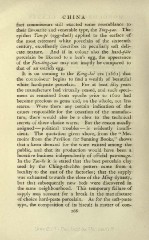Page 328 - Oriental Series Japan and China, Brinkly
P. 328
CHINA
fact connoisseurs still exacted some resemblance to
their favourite and venerable type, the Ting-yao. The
epithet Tan-pi (egg-shell) applied to the surface of
the most esteemed white porcelain of the sixteenth
century, excellently describes its peculiarly soft deli-
cate texture. And if in colour also the hard-pate
porcelain be likened to a hen's egg, the appearance
of the Fan-ting-yao may not inaptly be compared to
that of an ostrich egg.
It is on coming to the Kang-hsi era (1661) that
the connoisseur begins to find a wealth of beautiful
white hard-paste porcelain. For at least fifty years
the manufacture had virtually ceased, and such speci-
mens as remained from epochs prior to 1600 had
become precious as gems and, on the whole, not less
scarce. Were there any certain indication of the
causes responsible for the cessation of the manufac-
ture, there would also be a clew to the technical
secrets of these choice wares. But the reason usually
assigned political troubles is evidently insuffi-
cient. The quotation given above, from the " Me-
moirs from the Pavilion for Sunning Books," shows
that a keen demand for the ware existed among the
public, and that its production would have been a
lucrative business independently of official patronage.
In the Tao-lu it is stated that the best porcelain clay
used by the Ching-te-chen potters came from a
locality to the east of the factories that the supply
;
was exhausted towards the close of the Ming dynasty,
but that subsequently new beds were discovered in
the same neighbourhood. This temporary failure of
supply may account for a break in the manufacture
of choice hard-paste porcelain. As for the soft-paste
type, the composition of its biscuit is matter of con-
266

